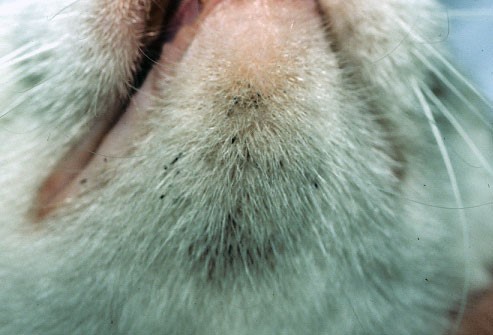 Feline acne is a common skin condition in cats. Cats of any age can be affected, and there is no breed or sex predisposition.
Feline acne is a common skin condition in cats. Cats of any age can be affected, and there is no breed or sex predisposition.
Cats are often presented to the veterinarian with the complaint of ‘dirt on the cat’s chin, that the owner cannot remove after attempts to clean it’ or ‘bumps on the cats chin’.
How does feline acne develop?
Hair follicles on the chin become blocked with secretions from small fat glands called sebaceous glands in the skin. This gives rise to multiple blackheads otherwise known as comedones on the chin, giving the chin the so-called ‘dirty appearance’. These comedones may also be associated with small red blisters or pimples and crusts on the surface of the chin.
In some cats, feline acne can be itchy, causing the cat to scratch and further damage the affected skin. Trauma to the surface layers of the skin often cause bacteria on the skin to start multiplying and cause infection, further complicating the clinical picture.
In severe cases, these plugged hair follicles may burst into the deeper layers of the skin, resulting in swelling, hair loss and draining tract formation. These draining tracts are often painful and your cat will be very reluctant to allow any touching or examination of this area.
The exact cause of feline acne is unknown, but there are multiple contributing factors, including:
- Hyperactive sebaceous glands with excess sebum (fatty discharge) production
- Clogging of hair follicles, when hair isn’t properly shed
- Stress
- A suppressed immune system (this includes abnormalities in the skin surface or the immune barrier function)
- Irritation with inflammation of the skin also called dermatitis which may be as a result of the skin coming into contact with something that irritates it or sometimes an allergy not related to contact but perhaps food or pollens
- Poor grooming habits (the chin is a difficult area to groom properly)
- Sensitivity to certain foods, chemicals or medications
How is feline acne diagnosed?
The first and foremost clue is the discolouration and swelling of the chin area (in most cases it is limited to that part of the body).
Apart from doing a thorough clinical examination the vet will also take a comprehensive history of the case.
The vet may ask you questions like:
- When did you first notice the comedones (bumps)?
- Is the condition getting any worse?
- Does the cat seem itchy on its chin?
- What is your tick and flea control program like?
- Have you made any recent changes to the cat’s diet, feeding bowls or feeding habits?
If no other abnormalities are found and further diagnostic tests are required, a tentative diagnosis of feline acne can be made. Feline acne lesions have a very characteristic appearance.
There are other conditions that can resemble feline acne, which include:
- mange (Demodicosis) caused by a mite burrowing into the deep layers of the skin
- yeast infections (Malassizia)
- allergies
- ringworm (Dermatophytosis) or
- eosinophillic granuloma complex which is an immune condition affecting the skin
Further diagnostic testing may be required to rule out the above mentioned conditions and your vet may want to do a skin scrape, bacterial or fungal culture or in certain cases a skin biopsy. Biopsy is where a small piece if skin is cut out under general anaesthesia and sent to a laboratory for examination.
How is feline acne treated?
Treatment is dependent on the severity of the condition. If only a few comedones are present, topical treatment is applied. Cleansing the skin with a diluted disinfectant which is not irritating to the skin like Hibitane or a Chlorhexidine solution, Betadene or Witch hazel is recommended daily. Be careful not to use any of the normal human skin disinfectants as the pH of human skin differs from animals and these product may irritate the skin and make the condition worse. Afterwards fresh aloe gel, colloidal siver or a topical glucocorticoid cream can be applied. If your cat will tolerate it, a warm cloth can be applied to the chin for one minute, this will open the pores and allow better cleansing of the affected skin.
In severe cases with ruptured pustules and secondary infection, the hair on the chin is clipped, the skin is cleansed as mentioned above and systemic antibiotics and glucocorticoids are included in the treatment protocol. As this condition can be quite painful most cats will not allow this kind of treatment without being aneasthetised or deeply sedated.
It is worth considering switching to stainless steel feeding bowls, as some cats are sensitive to plastics or the dyes used to colour plastic feeding bowls. This skin sensitivity, when exacerbated, can worsen the feline acne.
Feline acne may occur as a single episode or in some cats may be a recurring problem. The condition can however be controlled with proper treatment and your cat can have a good quality of life despite feline acne.
© 2018 Vetwebsites – The Code Company Trading (Pty.) Ltd.


